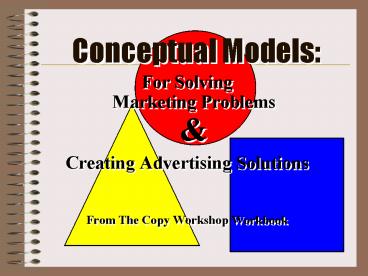Conceptual Models: PowerPoint PPT Presentation
1 / 24
Title: Conceptual Models:
1
Conceptual Models
- For Solving Marketing Problems
- Creating Advertising Solutions
- From The Copy Workshop Workbook
2
Kenichi Ohmae
- In business as on the battlefield
- the object of strategy is to bring about
the conditions most favorable
to ones own side. - In strategic thinking, one first seeks a clear
understanding of the particular character of each
element of a situation - and then makes the fullest possible use of human
brainpower to restructure the elements in the
most advantageous way.
3
Kenichi Ohmae
- Phenomena and events in the real world do
not always fit a linear model. - Hence, the most reliable means of dissecting
a situation into its constituent parts - and then reassembling them in the desired
pattern is not a step-by-step methodology such as
systems analysis. - Rather, it is that ultimate non-linear thinking
tool, the human brain.
4
Kenichi Ohmae
- No matter how difficult or unprecedented the
problem, a breakthrough to
the best possible solution - can come only from a combination
- of rational analysis based on
the real nature of things, - and imaginative reintegration of all the
different items into a new pattern - using non-linear brainpower.
5
(No Transcript)
6
The Strategic Triad
- The Problem (?)
- The Problem the advertising must solve.
7
The FCB Grid
- The FCB Grid reveals in a graphic, tangible way
how consumers approach the purchase of a
particular product or service.
THINKING FEELING
HIGH FEEL
HIGH THINK
Low Think - Practical and functional products
INVOLVEMENT
Low Feel - Sensate and pleasurable products
LOW FEEL
LOW THINK
High Feel - Products that reflect on you
High Think - Considered purchases
8
Exploding the Dot!
- Example Old El Paso (American brand of Mexican
Food)
High Think
High Feel
High Think Variety, good nutrition
Low Think Easy, economical, special savings
Low Think
Low Feel Fun and flavor. Ole!
Low Feel
High Feel Creative serving suggestions to
demonstrate your skills.
9
Laddering
- A good framework to analyze your product and how
it benefits the consumer.
Values
Consumer Benefits
- Go up and down the ladder to look for the
strongest lines of development.
Product Benefits
Features
- Generic vs. Specific
Attributes
10
The Learn/Feel/Do Circle
- Three behaviors associated with product
involvement
Feel
Learn
- Enter at any place
- Go in any direction.
- Learn/Feel/Do
- Learn/Do/Feel
- Feel/Learn/Do
- Do/Learn/Feel
Do
11
From 4As to 4Rs
- The 4 Rs
- Reaction
- Relevance
- Response
- Relationship
- The 4 As
- Attention
- Awareness
- Attitude
- Action
12
From 4Ps to 4Cs
- The 4 Cs
- Consumer
- Cost
- Convenience
- Communication
- The 4 Ps
- Product
- Price
- Place
- Promotion
- People (5th P)
Thanks to Robert Lauterborn
13
The MarCom Matrix
- Advertising
- Public Relations
- Sales Promotion
- Direct Marketing
- Event Marketing
- New Media/
- Interactive
14
Strategy Selection Grid
Product Class Definition Target Group Selection
Message Element Selection Rationale - based on
information and/or judgment
15
The Strategic Triad
- The Problem (?)
- The Problem the advertising must solve.
16
4 More Grids
- Positioning
- Marketing Warfare
- Boston Consulting Group
- Corporate Culture
17
Positioning
- Result of message overload
- Occurs in mind of consumer
- Often mis-used
- Good positions are usually very simple.
- Re-positioning can be very difficult.
1/BEST
AGAINST
NICHE
NEW CATEGORY
18
Marketing Warfare
- Result of competitive market overload
- Zero-sum game
- Uses principles of Von Clausewitz - military
strategist - Useful for planning and understanding competitive
situation
DEFENSE
OFFENSE
FLANKING
GUERRILLA
19
Boston Consulting Group
CATEGORY GROWTH
- Portfolio Management
- Useful model - but dont overuse
- Key issue - category growth
- Heres how it works...
STAR
COW
MARKET SHARE
?
DOG
20
Corporate Culture
LOW FEEDBACK HIGH
- Reasons for internal behavior
- May be different departments
- Helps us understand client cultures
- Helps us understand other behaviors
BET YOUR COMPANY
MACHO
HIGH RISK LOW
WORK HARD PLAY HARD
PROCESS
21
Combine Them
- Use them systematically
- Use them creatively
- Use them to present
22
Examples
- Discuss/suggest a Brand or Marketing Problem
- Use 2 different models on one problem
- Use as presentation intro
23
Thank You!
24
Thank You!
- Questions
- Discussion

